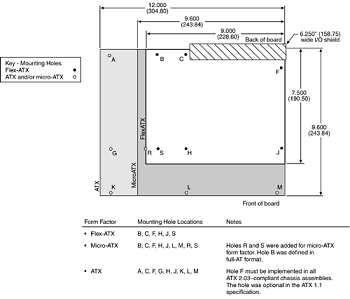Flex-ATX
In March 1999, Intel released the flex-ATX addendum to the micro-ATX specification. This added a new and even smaller variation of the ATX form factor to the motherboard scene. Flex-ATX's smaller design is intended to allow a variety of new PC designs, especially extremely inexpensive, smaller, consumer-oriented, appliance-type systems.
Some of these designs might not even have expansion slots, allowing expansion only through USB or IEEE-1394/FireWire ports. Flex-ATX defines a board that is up to 9''x7.5'' (229mmx191mm) in size, which is the smallest of the ATX family boards.
In all other ways, flex-ATX is the same as ATX and micro-ATX, making flex-ATX fully backward compatible with ATX or micro-ATX by using a subset of the mounting holes and the same I/O and power supply connector specifications (see Figure below).

Most flex-ATX systems likely use SFX/TFX (small or thin form factor) type power supplies (introduced in the micro-ATX specification), although if the chassis allows it, a standard ATX power supply can also be used. With the addition of flex-ATX, the family of ATX boards has now grown to include four definitions of size (three are the official standards), as shown in Table below.
| Form Factor | Max. Width | Max. Depth | Max. Area | Size Comparison |
|---|---|---|---|---|
| ATX | 12.0'' (305mm) | 9.6'' (244mm) | 115 sq. in. (743 sq. cm) | — |
| Mini-ATX | 11.2'' (284mm) | 8.2'' (208mm) | 92 sq. in. (593 sq. cm) | 20% smaller |
| Micro-ATX | 9.6'' (244mm) | 9.6'' (244mm) | 92 sq. in. (595 sq. cm) | 20% smaller |
| Flex-ATX | 9.0'' (229mm) | 7.5'' (191mm) | 68 sq. in. (435 sq. cm) | 41% smaller |
Note that these dimensions are the maximums allowed. Making a board smaller in any given dimension is always possible as long as it conforms to the mounting hole and connector placement requirements detailed in the respective specifications.
Each board has the same basic screw hole and connector placement requirements, so if you have a case that fits a full-size ATX board, you could also mount a micro-ATX, or flex-ATX board in that same case. Obviously, if you have a smaller case designed for micro-ATX or flex-ATX, you won't be able to put the larger mini-ATX or full-size ATX boards in that case.